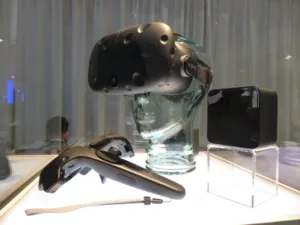The Game Developers’ Conference took place in San Francisco this month. With the advances in virtual reality, this event is becoming ever more relevant to display makers.
AMD estimates that it has an 83% share of the VR home systems market – including Sony’s Playstation 4, which will be used to run the Playstation VR. This is according to Jon Peddie’s Techwatch newsletter. Around 36 million PS4s have been sold to-date. In PCs, the availability of VR-ready units is lower; JPR believes that only Enthusiast-class add-in boards, in a Core i7 PC, qualify as VR-capable. The installed base of such devices is 10.4 million.
The firm also introduced its own VR Ready certification, to challenge Nvidia’s (Nvidia Certifies VR-Ready Systems). ‘Radeon VR Ready’ will be applied to GPUs that can power virtual reality, and is aimed at minimising consumer confusion in the space. HP has already signed up to the programme.
Additionally, AMD announced a new card called the Radeon Pro Duo. It is a single-slot device with 16TFLOPS of power and two GPUs (each with 4GB of RAM). At $1,500 it is the most expensive Radeon card to date. Despite the high-end specifications, however, gamers are not the target market: VR content creators are.
There were more VR demos from HTC, including the games Vanishing Realms, Giant Army and The Wave. According to Fortune (speaking to Valve’s Chet Faliszek), 50 developers already have HTC Vive store pages on SteamVR. He also announced that there would be no exclusives on the Vive at launch, saying, “We don’t think that’s a good thing for the industry, especially in VR where we’re starting out… We want to do everything we can to make sure VR succeeds, regardless of the platform. I don’t think a customer ever thinks a platform-exclusive game is a good thing.”
Version 1.0 of the low-level Vulkan API (Imagination Video Encoding is High Quality), from the Khronos Group, is now available, Imagination Technologies announced. The API has been designed for portability across multiple platforms, including desktop and mobile GPU architectures.
Imagination announced v4.1 of the PowerVR Graphics SDK; the Vulkan SDK includes the PowerVR framework.
Microsoft surprised everyone – and doubtless made some very happy – with its announcement of cross-platform play. Going forward, Xbox One and Windows 10 users using Xbox Live will be able to play with gamers on different platforms – including the Playstation Network. Support for this feature will be up to the game developers.
Sony revealed the price of its own head-mounted display, the Playstation VR. The headset comes in considerably cheaper than its immediate competitors (the Oculus Rift and HTC Vive), at $400 – although it will be available several months behind them too; it is set to be launched in October.
Specifications for the VR were also finalised. The display is a 5.7″ OLED, with 1920 x 1080 resolution (960 x 1080 per eye). It will have a 120Hz refresh rate, 100° field of view (very important for gaming!) and latency of less than 18ms. More details will be shared at E3 in June.

